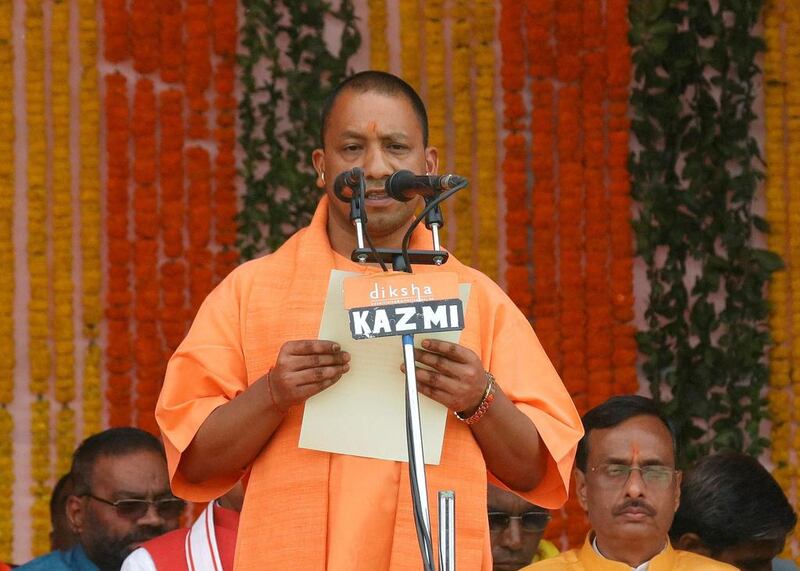In the days following Yogi Adityanath’s installation as the chief minister of Uttar Pradesh, events with a distinct Hindu nationalist flavour began to transpire across India’s largest state.
Adityanath, a hard-line member of prime minister Narendra Modi’s Bharatiya Janata Party (BJP), was named chief minister on March 18. Shortly thereafter, the state’s bureaucracy and police began to close down dozens of slaughterhouses.
The butchery and meat-processing industry is dominated by Muslims, but the authorities insisted that they were merely forcing the closure of businesses that were operating without due permits or that were illegally slaughtering cows. The police also launched an “anti-Romeo” drive, hassling young men or unmarried couples while claiming only to be protecting women from street harassment and molestation.
These developments bear the hallmarks of Hindu nationalism: puritanism, a fierce anti-Muslim sentiment and majoritarianism.
Adityanath, a five-time parliamentarian, has a record of right-wing virulence; he has been accused, in three separate incidents, of a clutch of crimes, including attempted murder, instigating enmity between religious groups and rioting.
He has frequently urged India to become a Hindu nation, and he advocates building a temple in the Uttar Pradesh town of Ayodhya, on the very site where a 16th-century mosque was razed by Hindu fanatics in 1992. His accession to the chief ministership of a state in which a fifth of the 200-million-strong population is Muslim signals tense, potentially ugly times ahead.
Adityanath is a member of the Hindu clergy, a priest at the Gorakhnath Temple in Gorakhpur, a town in north-eastern Uttar Pradesh. This is a neat coincidence, for Gorakhpur is also home to a publishing house named Gita Press, little-known outside India but famous within the Hindu community.
Nearly a century old, Gita Press is the world’s largest publisher of Hindu religious texts. Since its inception, it has run off half a billion copies of various books, including 114 million copies of the Bhagavad Gita, a central work of Hindu philosophy.
Through its lifetime, Gita Press has been instrumental in twinning Hinduism with nationalist politics, twisting the two strands tightly around each other. To a great degree, Gita Press has been instrumental in crafting modern Hindu nationalism – the very movement that has brought its fellow Gorakhpuri, Adityanath, to one of the most powerful political positions in India.
Founded in 1923 by a pair of businessmen, Gita Press began publishing its texts just as the Indian independence movement was fracturing along religious lines. Throughout Uttar Pradesh – then called United Provinces – riots raged over the issue of protecting the cow, an animal held sacred by Hinduism but also a source of meat for Muslims. The newly founded Hindu Mahasabha, a political party, was campaigning for the “reconversion” of India’s Muslims to Hinduism, believing their ancestors to have once been forcibly converted from Hinduism by Islamic invaders.
Sectarian politicians were realising that, by harking to the purity of a bygone Hindu identity, it was possible to forge a new national consciousness – an asset of immense value as India struggled to throw off the British yoke.
Gita Press capitalised on, and advanced, all these preoccupations. Its religious texts aside, it printed a monthly journal named Kalyan (or “Auspicious”) in Hindi, which contained commentaries and columns on religion and spirituality; Kalyan is still being published today, with a circulation of around 200,000 per issue.
Once a year, Kalyan came out as a special issue revolving around a particular theme: the cow, for instance, or the role of the Hindu woman, or the ideal Hindu child.
The journal’s moral universe was always unambiguous. Women belonged at home, and their chastity was part of Hinduism’s honour; the cow was to be venerated and protected; Muslims were to be feared or mistrusted.
Kalyan believed that “the all-round decline in society was the result of Hindus having moved away from the path of religion,” Akshaya Mukul wrote in his 2015 book Gita Press and the Making of Hindu India. What was needed, the ideologues of Gita Press reasoned, was to restore Hinduism to the centre of Indian life.
These views overlapped perfectly with the growing influence of the Hindu nationalists, and Gita Press was glad to serve as their “footsoldier”, Mukul observed. Frequently, the leading lights of these nationalist groups were given column space to expound upon their theories.
As India lit up with religious violence in the months leading to Partition in 1947, Kalyan abandoned its spiritual mission for a temporal one, explicitly urging Hindus to seek retaliatory violence if they were attacked by Muslim mobs.
The journal’s editor criticised Mahatma Gandhi, who frequently defended the Muslim minority and urged the Hindu majority to be more tolerant. In February 1947, as the Muslim League pressed for the creation of Pakistan, a poem in Kalyan included the grim threat: “If we wish, today the achievement of Pakistan can be drowned.”
Even after India gained independence, Kalyan continued to play upon its pet themes. Its ideas came from, and were then reabsorbed by, the political outfits of Hindu nationalism: the Rashtriya Swayamsevak Sangh (RSS), of which Mr Modi was once a full-time member, and the BJP.
The journal was, for instance, one of the earliest champions for the construction of a temple in Ayodhya, believing that the deity Rama had been born at the very site where the mosque stood; the mob-driven demolition of the mosque in 1992 was, in a way, partially ignited by the ideologues of Gita Press. That controversy still resonates today.
After the results of the Uttar Pradesh election were announced on March 11, Adityanath confirmed that the plan to build the temple in Ayodhya figured prominently upon his party’s horizon.
The elevation of Adityanath marks a watershed in Indian politics. The BJP has governed India before, but never in the history of modern India has Hindu nationalism achieved such deep and wide political power at both federal and state levels.
Nearly two-thirds of India’s population now lives in states run by the BJP, and Mr Modi enjoys a historic majority in the lower house of parliament. The party has long desired to capture power in Uttar Pradesh, and now it has won a clear majority in the state for the first time in 26 years.
For decades, religion and politics have been expertly and dangerously blended by Gita Press of Gorakhpur; now another practitioner from the town is in position to push this flammable mix into a full-blown fire.
SSubramanian@thenational.ae





